Labour of love
The sounds of birds, the scents of trees and freshly mown grass and sunlight playing though the leaves. Wandering into Elliot and Lauren Callender’s garden on a baking hot Gisborne day felt like an instant detox, a reminder of how good nature can make us feel.
Being part of the Gisborne Garden and Arts Festival was a first time experience for the couple and something Elliot says he particularly enjoyed after six years creating their
dream garden. “It was special to be able to share it with other people and seeing them inspired by what we’ve managed to achieve was really rewarding.”
Lauren credits Elliot with most of the hard work. “I mow the lawns and do the bits around the edges but Elliot literally does all the other physical work outside. He is normally the one spreading the mulch, trimming the hedges, fixing things, and planting trees.”
Elliot has the kind of DIY skills that come in handy when developing a large garden on a slope. But he didn’t stop at the all important steps, decks and retaining walls. Six-year-old Harvey and four-year-old Toby have bespoke play equipment that would be the envy of any child, including a magnificent ‘super-slide’ whizzing through the trees.
For Lauren, who is an interior designer, the garden is an extension of the house. “What I find most rewarding is creating spaces for people to enjoy, whether it’s a nice place to sit under a shady tree or a place to run and play. It’s a creative outlet for me.”
When they first came across the property six and a half years ago, Lauren and Elliot couldn’t believe their luck. The large tree-clad site on the hill above Gisborne port ticked all their boxes. It gave them the sense of seclusion and open space they had been dreaming of. They had started their family and had Daisy the Rottweiler, so a larger garden was top of the wish list.
They were faced initially with a very overgrown garden filled with a daunting variety of plants. “Not just one style, but everything you could think of,” says Lauren. “We knew it had huge potential but we didn’t know where to start.”
A breakthrough came when they visited the garden of their friend Jo Higgins-Ware. “In just seven years they’d converted their hillside property from farmland into a stunning garden, mostly with natives. Once we saw Jo’s garden, we knew exactly where we wanted to go with ours. We both got inspired and we were on the same page,” says Lauren.
Jo recommended that they work out the journey they wanted around the garden first, and put down paths. Also, before any planting could begin, there were some drainage issues to fix along with the selective removal of overgrown vegetation.
The best trees revealed themselves as they cleared the section. “We were really picky about the trees we kept,” says Lauren. The wide variety of both exotic and native trees remaining includes some that will eventually be removed to make space for new trees such as the four pohutukawa they have planted. A large titoki tree has earned its right to stay because of the kereru it attracts to feast on its fruit.
One of Lauren's most treasured trees is a large weeping cherry. ‘We love its bright pink blossoms in spring, the gorgeous autumn colours and the wonderful summer shade.” The tree’s wide spreading branches support a hanging chair and a child’s swing. Charming stepping logs meander through the shade-loving groundcover plants, completing this idyllic space for relaxing with children on a sunny day.
Shrubs, ground covers and hedges were planted zone by zone. “We did some areas and then did them again,” says Lauren. They started with straight hedges before they realised curved hedges worked much better with the contours of the garden. ”We’ve learned that you can move whole hedges if you want to!”
Lauren and Elliot enjoy the simplicity of mass planted ground covers. In areas where others might have chosen lawn or high maintenance flower gardens, they’ve opted for tough groundcover shrubs like Coprosma, with stepping stones making a way through. Bounded by hedges are large swathes of grasses and green flax with yellow flowers that attract native birds.
Wood chip covers the ground between new plantings. “Until Jo emphasised the importance of mulch we hadn’t really thought about it,” confesses Lauren. But they quickly saw its benefits and are grateful to their arborist neighbour who supplies them with all the mulch they need.
Lauren credits her mum as a key advisor on all things gardening. “As a child I remember Mum was always in the garden. Every time we travelled she would want to look at a different garden centre. Which I now understand! These days’ I’ll sit down with Mum and we’ll watch Monty Don.” Her sister too is naturally green fingered.
While her mother and sister are great with flowers, Lauren’s focus is mainly on foliage, which she finds is easier to manage and easy on her eye. In a large pot next to a karo hedge she has planted Convolvulus cneorum around an olive tree, in a smart juxtaposition of silvery greens. She enjoys playing around with different foliage combinations saying, “I’m probably more fussy than I realise. I think and think about it, then usually Mum comes along and we think about it together and then I go aha, that’s it!”
Flowers, mainly white, are displayed in pots on the deck. “That’s where I’ll mainly see them and won’t let them dry out,” says Lauren. And she has also devoted just one raised bed for experimenting with flowers, with which she is ruthlessly selective, saying, “If I don’t love it, it’s ‘out you go’!” Among the current keepers here are drought tolerant perennial Salvia, Gaura ‘So White’, Echinacea, Echinops, Verbena, Dichondra ‘Silver Falls’ and swan plants for the butterflies. Lately she has been trying out different grasses with the flowers, enjoying bronze Carex and blue Festuca. Mini toetoe (Chionochloa) is next on the list to try.
Lauren is discovering new plants every day, with no shortage of gardening projects on her horizon, including a new vege garden planned once the house renovations are done. Her advice for others starting out? “Limit the types of plants that you are going to put in. Keep it simple but plant what you love. Also, a good lawn is like the icing on the cake and will really set off the garden”.
A child-friendly garden
How to make a garden the most enticing place for learning, imagination and discovery…
Engaging all senses
Plant a wide variety of interesting textures, colours, and scents.
Bird watching
A garden thats provides and irresistible habitat for birds is also irritable for children who love to engage with nature. In the magnolia tree above a hammock Toby showed me a birds nest.
Bug watching
Insects provide a wonderful opportunity to learn about the life cycles, pollinators and other fascinating intricacies of nature. Teach children to look after beneficial insects and how to be safe around bees.
Grazing
A snack picked and eaten straight from the garden is far more enticing than one served up on the dinner plate, especially if you were involved in growing it. Child friendly planting includes the likes of fruit trees, blueberries, snow peas, broad beans, crunchy cucumbers and cherry tomatoes. Teach them about the dangers of eating unknown plants.
Space, shade and safety
A wide open space with a soft, hazard free lawn to run and play or kick a ball is worth prioritising for a young family. In a smaller garden, free up space by keeping planting and play equipment around the boundaries. Play spaces need protection from the sun. Make the most of any trees as the ultimate sun shade. Soft surfaces are important under play equipment. Fencing of swimming pools, roads and other unsafe areas is critical.
Fun!
Play equipment doesn’t need to be an expensive eyesore. Challenging yet safe play elements can be integrated into green spaces to maintain an exciting sense of wilderness. Choose materials that blend with the natural environment. Something as simple as a set of log stepping stones or a rope swing hanging from a tree can provide hours of fun.
Future proofing
Plan for change as children grow. A sandpit may be a future garden bed. A playhouse may be a future storage shed.

1-Mar-2022
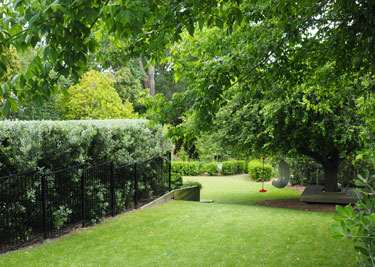
"What I find most rewarding is creating spaces for people to enjoy, whether it's a nice place to sit under a shady tree or a place to run and play"

Golden flax flowers provide a feast for native birds
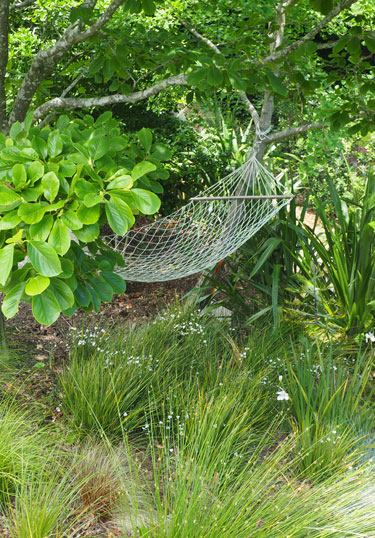
A relaxing spot under the magnolia trees with Libertia (NZ iris) and Carex grasses as groundcover

Mature trees make a perfect bespoke climbing frame
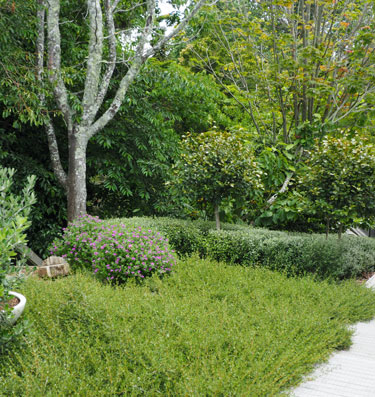
Coprosmas provide thick low-maintenance groundcover and contrasting texture
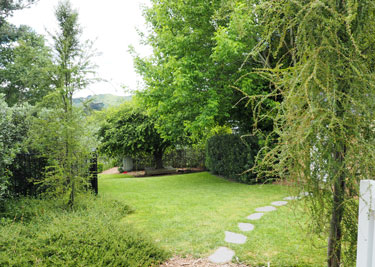
A pair of weeping mapou mark the entrance to a spacious gently sloping lawn.
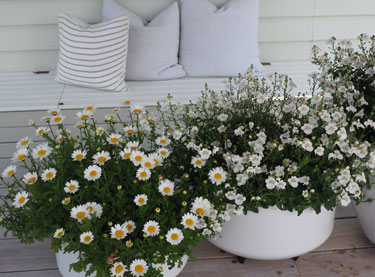
Leucanthemum paludosum daisies and Diascia Genta White

